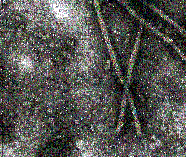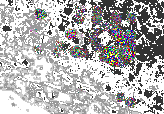







ProteinBioSynthesis (old)
new version: please go to: Sonifying Protein Bio Synthesis
Converting standard genetic text files into patterns,
this is maybe a first step towards Biomolecular Computing in SC...
"With the discovery that a set of symbols has been used by nature to encode the information for the construction and maintenance of all living things, semiotics - the analysis of languages and texts as sets of signs and symbols - has become relevant to molecular biology. Semiotics has given students of the DNA text a new eye for reading, allowing us to argue for the validity of a multiplicity of meanings, or even for the absence of any meaning, in a stretch of the human genome." (Pollack 1994: 12)
read an interview about biopiracy
myRibosome (an SCPlay application)
Genetics.hqx (incl. help file and some examples (sc3d5))
ProteinBioSynthesis (contains translation Dictionaries)
AminoacidNames (converts from aminoacid index to name)
GenomePattern (returns base letters)
CodonPattern (returns triplets (codons))
AminoacidPattern2 (returns an array of index and codon)
AminoacidPattern (returns aminoacid indices)
Ptranscribe (return only the aminoacid indices between start- and stopcodon)
AminoacidPattern3(returns an array of index and name)
sample genetic resources you can use to produce sound:
escherichia coli
Caenorhabditis elegans: Cruzia americana cytochrome oxidase subunit
Bacteriophage 3/14
Orangutan hepadnavirus
Hepatitis B virus
a section of a y-chromosome
Homo sapiens hypothetical protein MGC3200 (MGC3200), mRNA
Salmo salar ultraviolet opsin mRNA
Agrobacterium larrymoorei 16S rRNA
to find more browse the http://www.ncbi.nlm.nih.gov
search for genome and download the page. You can open any html page
source code with the supercollider Genetics class GeneFile. If it is
a larger file, it might take quite a while. Usually it takes a couple of seconds.
(only lowercase base letters are supported at the moment)
Flicker Comparison of cDNA microarray images
Honiglab Imaging
this program was developed during the Telenautic Genome Project
for viruses see also Sammlung Rohrhuber

What happens in a ribosome?
In a process that is called transcription, specialized enzymes open up
the bindings within the DNA doublehelix and produce a complementary copy
of the base pattern that is called messenger RNA (mRNA).
This single chain of nucleotides gets passed out of the core of the cell
onto a structure called the epr (endoplasmatic riticulum) that acts like
an intra-cellular transport system. On its surface there are large amounts
of small round entities, the ribosomes, that translate the incoming mRNA into proteins.
The ribosome always binds three nucleotides at a time and connects an aminoacid
each to a growing chain. As aminoacids have various properties and shapes,
this protein chain folds in a characteristic way that depends on complex factors
and acts like a tool in the world of cellular chemical reactions.
It must be mentioned that as a result of the everpresent brownian motion all molecules
at this scale shake with an enourmous intensity - if they were more static, all those
reactions couldn't happen.
These Patterns model the behaviour of ribosomes a close as meaningful.
The sound is not mapped to individual nucleotides (the four letters), but to aminoacids.
Aminoacids do not make sound really, so the mapping can be left to the musicians taste.
Nevertheless, some mappings might be more meaningful than others.

this topic is a classic one.
one of the interesting links you may find is:
http://www.npr.org/programs/morning/features/2001/010212.cellsounds.html
a lego genome and other visualisations: http://www.chemicalgraphics.com/paul/
::
Links to this Page
- Public Library 3 last edited on 27 October 2006 at 9:41 pm by host81-159-217-15.range81-159.btcentralplus.com
- Biomolecular Computing last edited on 7 July 2001 at 6:27 pm by 134.100.176.73
- enter. last edited on 29 January 2003 at 10:46 pm by 203.14.169.19
- MyRibosome (old page) last edited on 11 August 2005 at 10:49 am by e176084095.adsl.alicedsl.de
- ZEP Spezial last edited on 9 April 2002 at 12:49 am by max2-050.dialin.uni-hamburg.de
- Public Library SC2 last edited on 2 March 2005 at 2:20 pm by max2-223.dialin.uni-hamburg.de

